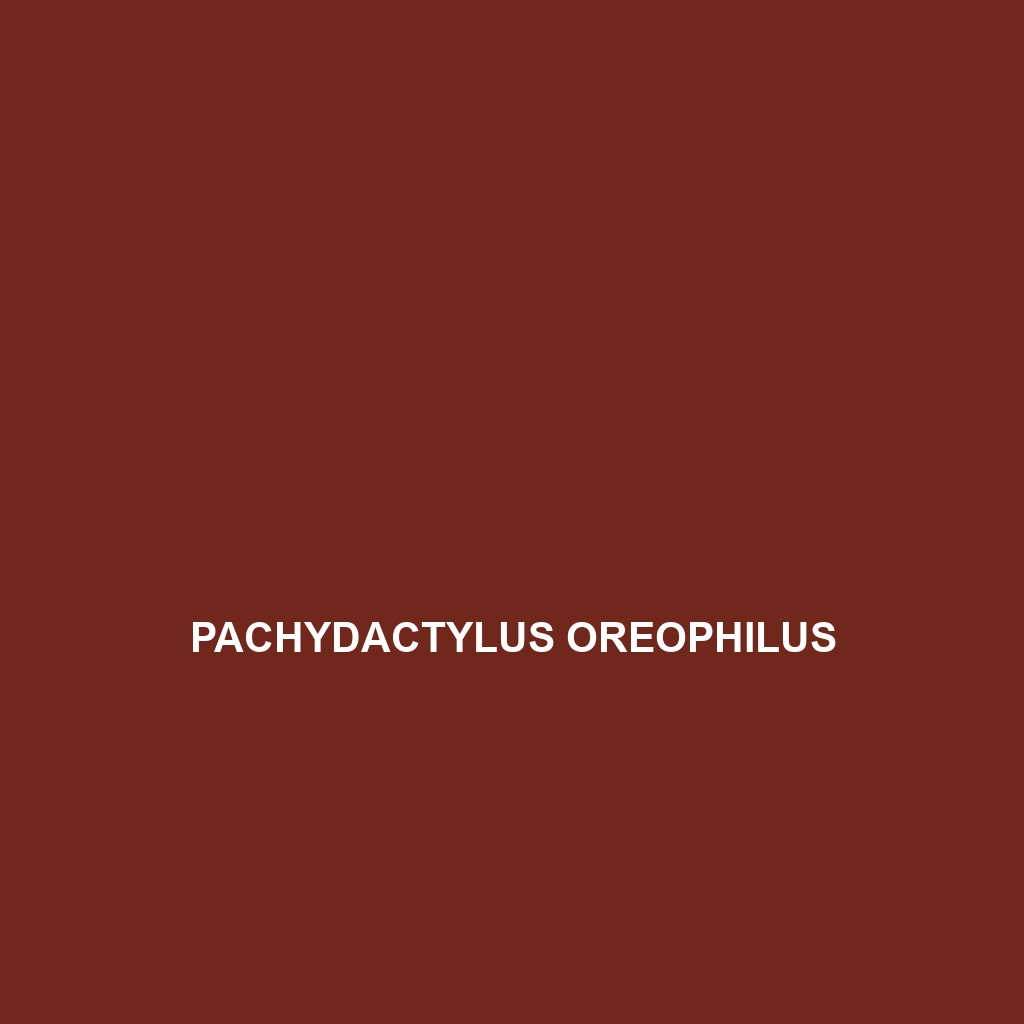Common Name
Pachydactylus oreophilus
Scientific Name
Pachydactylus oreophilus
Habitat
Pachydactylus oreophilus is primarily found in arid and semi-arid regions of southwestern Africa, particularly within the mountainous areas of Namibia and South Africa. This species thrives in rocky outcrops and savannas characterized by sparse vegetation and distinct temperature fluctuations. Its preferred habitats include rocky hillside terrains and dry riverbanks, where it can easily camouflage itself against the earthy tones of the environment. The climatic conditions of these areas often feature hot summers and cooler winters, making them ideal for the unique adaptations of the Pachydactylus oreophilus.
Physical Characteristics
Pachydactylus oreophilus exhibits several distinctive physical traits that contribute to its identification. Adults typically measure around 8 to 12 centimeters in length. This gecko species is notable for its broad, flattened body and large, elongated toes that resemble fingers, which facilitates climbing and gripping on rocky surfaces. The coloration of the Pachydactylus oreophilus ranges from sandy beige to light brown, embellished with darker mottling that provides excellent camouflage against its natural habitat. The skin is smooth with subtle granular textures, and individuals possess prominent eyes that enhance their vision, particularly during the dusk and dawn periods when they are most active.
Behavior
The behaviors exhibited by Pachydactylus oreophilus are a fascinating aspect of its ecology. This species is predominantly nocturnal, displaying increased activity during the cooler hours of the night when temperatures drop. During the day, these geckos are known to retreat into crevices and shaded areas to avoid the harsh sun. Mating rituals involve a series of elaborate displays; males perform push-up motions to attract females, showcasing both strength and readiness. Social interactions are generally low as these reptiles are solitary creatures, coming together primarily for mating purposes.
Diet
The diet of Pachydactylus oreophilus primarily consists of insects, categorizing it as an insectivore. Its feeding patterns vary with the seasons, as they primarily consume crickets, moths, and beetles, capitalizing on the abundance of prey available during the warmer months. The hunting method employed by this gecko often includes ambush tactics, where it blends into the surroundings before striking quickly at passing insects. This feeding behavior demonstrates significant adaptability to their environment, allowing them to thrive despite the challenges posed by limited food resources.
Reproduction
The reproductive cycle of Pachydactylus oreophilus typically occurs during the wetter months, aligning with the seasonal increase in insect populations. Mating usually takes place in late summer, with females laying a clutch of one to three eggs in moist, sheltered locations to enhance the likelihood of survival. The incubation period for the eggs ranges from 60 to 90 days, depending on environmental conditions. Once hatched, the juveniles are independent from birth and exhibit similar behaviors to adults; however, they tend to be more secretive as they seek to avoid predators during their vulnerable early life stages.
Conservation Status
According to the International Union for Conservation of Nature (IUCN), Pachydactylus oreophilus is currently categorized as a species of “Least Concern.” Despite having a stable population in certain areas, habitat destruction due to agricultural development and urbanization poses a potential threat. Conservation efforts are needed to monitor their habitat and educate local communities about the importance of these reptiles in maintaining ecological balance. Preserving their natural habitats through responsible land management is crucial for ensuring their continued survival.
Interesting Facts
One fascinating aspect of Pachydactylus oreophilus is its ability to change its skin color slightly depending on the environmental conditions, an adaptation that helps with camouflage. Furthermore, this species is known for its unusual defense mechanisms; when threatened, it can drop its tail, allowing it to escape while the predator is distracted. Additionally, Pachydactylus oreophilus has been observed engaging in a unique form of communication through body language and signal displays, making it a subject of interest for herpetologists and reptile enthusiasts alike.
Role in Ecosystem
Pachydactylus oreophilus plays a vital role in its ecosystem as both a predator and prey species. As an insectivore, it helps control insect populations, contributing to the overall health of its habitat. Furthermore, it serves as a food source for larger predators such as birds of prey and serpents, thus maintaining the balance of the food web. By facilitating the control of herbivore populations through its feeding habits and providing nourishment to higher trophic levels, the Pachydactylus oreophilus is an important keystone species within its ecological niche.
